The Global Economy prompts Radicalization
October 27, 2014 Leave a comment
The technological advance in all spheres and the Internet keeps people around the globe informed, while the economy underperforms in most global markets. The ideology of trickle-down Capitalism could not prevent or shorten the 2007-9 recession, neither it can boost the anemic post-recession recovery in the European Union, the Middle East, Africa or South America, (if realistically, a recession with limited less than 1% growth constantly sinking underwater markets could be considered over). Simultaneously, the growing inequality concentrates the highest percentage wealth into a smaller number of ultra-rich ravaging the middle-class, wherever it is succeeded, or not providing a condition for establishing one.
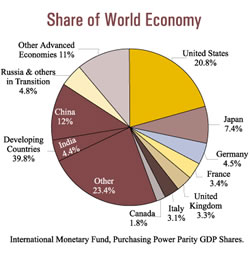 What the researchers find is that global wealth has increased every year since 2008, and that personal wealth seems to be rising at the fastest rate ever recorded, much of it driven by strong equity markets. But the benefits of this growth have largely been channeled to those who are already affluent. While the restaurant workers in America struggled to achieve wages of $10 an hour for their labor, those invested in equities saw their wealth soar without lifting a finger. So it goes around the world.
What the researchers find is that global wealth has increased every year since 2008, and that personal wealth seems to be rising at the fastest rate ever recorded, much of it driven by strong equity markets. But the benefits of this growth have largely been channeled to those who are already affluent. While the restaurant workers in America struggled to achieve wages of $10 an hour for their labor, those invested in equities saw their wealth soar without lifting a finger. So it goes around the world.
The bottom half of the world’s people now own less than 1 percent of total wealth, and they’re struggling to hold onto even that minuscule portion. On the other hand, the wealthiest 10 percent have accumulated a staggering 87 percent of global assets. The top percentile has 48.2 percent of the world wealth.
Under such conditions, it becomes natural for the dark human forces that prompt discrimination, nationalism, and narcissism to bloom. There is plenty of economic data to support appointed statements; however, the effect of these developments on the rising radicalization is not researched to its full extent. The world media tends to politicize global instabilities: the Arabian Spring, the ISIL, the Crimea’s take over, e.g. are either associated with harsh regimes such as the Mubarak’s in Egypt, Khadafy’s in Libya, or the US war on terror in Iraq and Afghanistan, or the religious fanaticism such as ISIL and Al-Qaida, or the Mr. Putin policies in Russia. However, very few journalists or economists attempt looking beyond the obvious into the fundamental reasons for such profound radicalization of religious, nationalistic, and other ideas that remand such disharmony instead of the prevailing ideas that the world is a better place, where generally, genocide, cruelty, aggression are attitudes of the past of a matured humanity.
Even when US-led Coalition waged war on Saddam Hussein in Iraq, or on Al-Qaida in Afghanistan, the idea was to instigate “good” over “evil”, democracy over dictatorship. Certainly, the ideas of liberties, human rights, and righteousness were the Coalition’s standing-points in decision-making: from the political to down on the field strategic ones. Humanitarian approach, even in time of war was considered paramount.
The cruelty with which ISIL treats their enemies, chopping heads and raping girls even when many well educated and “civilized” ISIL participants came from all over the developed world, or the self-centered Russian aggression by occupying Crimea and by provoking unrest and mingling with their neighbor Ukraine’s territorial integrity that already cost thousand of killed are considered uncivilized and unthinkable; The widely accepted noble ideas: obviously, are not the status-quo,
Historically viewed: a Half-Century bettered economically world created for themselves an illusion of invisibility, but when the global economies slammed causal the last 2007-9 Recession and the following slow recovery (if such could be called recovery) by bringing insecurity and poverty to many, the world remands aggression and radicalism to hound our sense of justice.
The recession slam was instigated by the:
1) Imbalance in real estate overcapitalized prices;
2) Slow down in industrial production and related industries causal of the ongoing globalization and rising productivity;
3) China’s super-industrialization and the outsourcing and moving of industrial production from the developed economies to elsewhere;
4) Internet and Twitter, Facebook, and etc networks;
5) Earth pollution that affected weather-prompting extremities.
The developed economies from UK and US to China and Japan dealt through unorthodox economic policies of quantitative easing, subsidies, fiscal stimulus, targeted investment packages into infrastructure and business development to boost their growth, and with idea that their success will improve the global economy. Many of Emerging Markets (China not included) were constrained from pursuing counter-cyclical measures by the WB and IMF, or by the European Union in case of their members and associate members. EU, under Germany, followed and continues the trickle-down budgetary economics of austerity measures (pro-cyclical by nature) resulting in prolonged in-and-out recession and a very limited “recovery” (as the data shows).
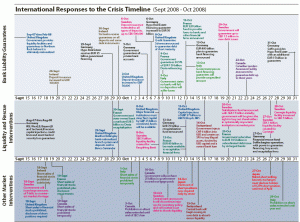 Domestic US timeline The domestic US timeline begins in June 2007 and shows the lead-up to and development of the crisis, as well as subsequent US government responses. The timeline is divided into three sections: Federal Reserve policy actions, other policy actions, and market events, to enable users to view Federal Reserve and other policy actions in the context of major market events.
Domestic US timeline The domestic US timeline begins in June 2007 and shows the lead-up to and development of the crisis, as well as subsequent US government responses. The timeline is divided into three sections: Federal Reserve policy actions, other policy actions, and market events, to enable users to view Federal Reserve and other policy actions in the context of major market events.
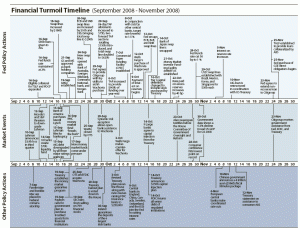 International timeline
International timeline
The international timeline provides a thematic and chronological ordering of the many programmes announced by G7 countries since the intensification of the global financial crisis in the fall of 2008. It organizes announcements into four general categories: bank liability guarantees, liquidity and rescue interventions, unconventional monetary policy, and other market interventions. The entries are color-coded to allow users to follow the developments of each country individually.
What the global market experiences, because of these pro-cyclical policies, is extreme stagnation, lack of growth, high unemployment, and solid retraction from the humanitarian values that had been built for a Half of Century, up to the beginning of this one. The discriminatory immigration policies loomed in the US, France, UK, e.g. steering nationalism,“Racism and xenophobia, intolerance and Islamophobia are on the rise,” warns José Manuel Barroso, President of the European Commission. “They foster division and create suspicion and hatred between communities. In recent years, we have even seen a mounting wave of harassment and violence targeting asylum seekers, immigrants, ethnic minorities and sexual minorities in many European countries.”One need not look far to see that President Barroso has a point. In February 2014, the Swiss population voted – albeit by a tiny majority – to reintroduce stringent quotas on immigration from EU countries. A few months later, in May 2014, anti-immigrant parties made significant gains in the European elections. In July, pro- and anti-immigration demonstrators clashed in Murrieta, a town in southern California, over the arrival of illegal immigrants – mainly children – at a border control station.
However, the most economically affected areas of the Middle East, Africa, and Eastern Europe, e.g. exploded out. When the two Charts/World Maps: the first indicates “People Displaces by Conflict and Violence 2014” and the second indicates “World Wealth Levels 2014” seemingly the data matches indiscriminately. There is a straightforward interrelation between the economic upheavals ravaging most markets around the globe and the forces invoking the dark human sides and the emerging conflicts. Targeted economic actions are required to prevent their expansion, indeed. To continue the business, as usual, seems very dangerous for the entire Humanity!
It is of high importance for the most developed economies and China, WB and IMF to start acting responsibly in promoting global economic development, also environmentally friendly one, but not rely on the “old” system of the so-called orthodox economics.
Joshua Konov 2014
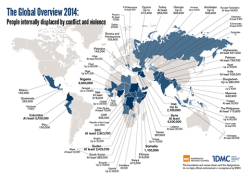
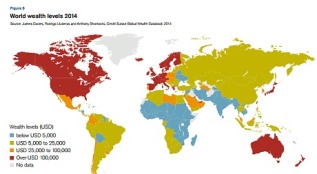
Recent Comments